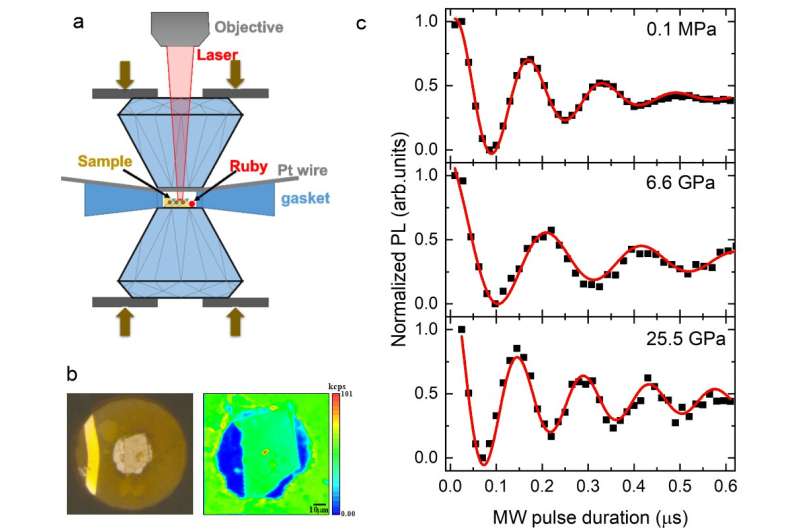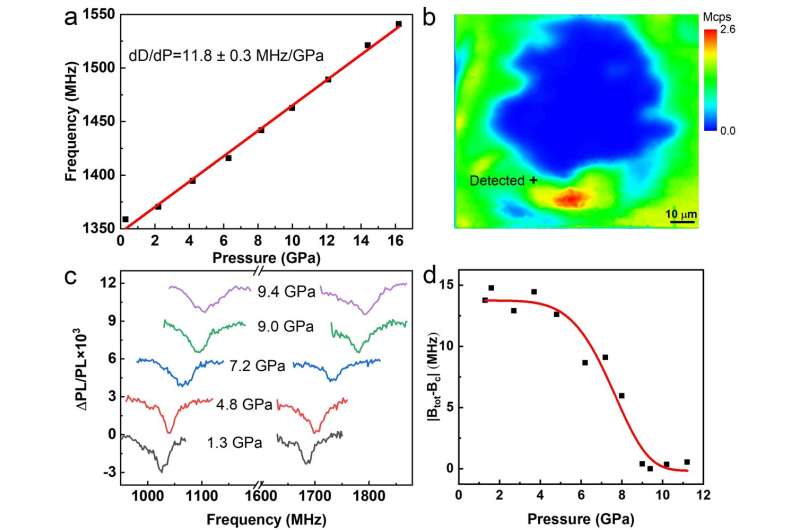Novel quantum detection method for in-situ sensitive magnetic measurement under high pressure

Substances exhibit many novel properties under high pressure, for example, pressure can induce insulator-metal or even superconductor transitions. However, in-situ magnetic measurement is always a difficult problem in high pressure research and restricts the study of a superconductor’s Meissner effect and magnetic phase transition behavior of magnetic materials at high pressures.
A new high pressure in-situ magnetic detection method was developed recently by a collaborative research group of Hefei Institutes of Physical Science (HFIPS) of Chinese Academy of Sciences, University of Science and Technology of China, and Sichuan University. The discovery paves the way for using divacancy in quantum technologies as pressure sensing and magnetic detection at high pressures.
The results were published in Nano Letters.
“Now, for the first time, we realized coherent control and high-pressure magnetic detection of divacancy defects in SiC spin quantum states under high pressure,” said Liu Xiaodi, co-lead of the project and associate Professor from HFIPS.
In this research, the team used spin quantum sensing technology of silicon carbide divacancy defects, diamond anvil cell (DAC) technology, and optically detected magnetic resonance (ODMR) technology. Based on these approaches, the team realized coherent control of the quantum states of silicon carbide divacancy defects under high pressure and magnetic detection based on the spin of silicon carbide divacancy defects.

The divacancy defect spin in silicon carbide is highly responsive to external pressure and magnetic field, and these responses can be measured by highly sensitive ODMR spectra, thus characterizing the pressure and magnetic state of the sample under high pressure.
The optical and spin properties of divacancy defects in SiC under high pressure have been systematically studied. The results show that the pressure sensing sensitivity of double vacancy PL5 defect is 0.28MPa/Hz-1/2. And based on the coherent control of spin quantum states of divacancy in SiC under high pressure, the ferromagneto-paramagnetic phase transition of magnetic Nd2Fe14B was detected under high pressure.
More information:
Lin Liu et al, Coherent control and magnetic detection of divacancy spins in silicon carbide at high pressures, Nano Letters (2023). DOI: 10.1021/acs.nanolett.2c03378
Citation:
Novel quantum detection method for in-situ sensitive magnetic measurement under high pressure (2023, February 22)
retrieved 22 February 2023
from https://phys.org/news/2023-02-quantum-method-in-situ-sensitive-magnetic.html
This document is subject to copyright. Apart from any fair dealing for the purpose of private study or research, no
part may be reproduced without the written permission. The content is provided for information purposes only.
For all the latest Science News Click Here
For the latest news and updates, follow us on Google News.

